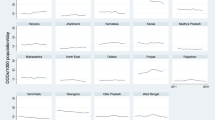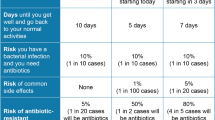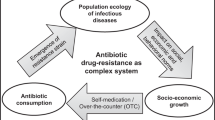Abstract
Because of bacterial resistance, current antibiotic consumption is reinforced by past use, and future utility is lower. The purpose of this article is to provide evidence on habit and addictive behavior toward antibiotics by exploring variations in the average consumption of antibiotics across 20 Italian regions. Using a balanced panel data set (2000–2009), we estimate myopic and rational addiction models, in which antibiotic consumption depends upon demographic and socioeconomic characteristics of the population, the supply of health care in the community, antibiotic price, and the “capital stock” of endogenous bacterial resistance measured by past and future consumption. Our empirical evidence shows that past antibiotic consumption stimulates current consumption and is also consistent with the rational addiction hypothesis. The low price elasticity of antibiotic demand suggests that policy measures targeted at antibiotic co-payments may not be effective in controlling antibiotic consumption. There is scope for other policy interventions, such as incentives and information campaigns targeted at doctors.
Similar content being viewed by others
References
Anderson TW, Hsiao CH (1982) Formulation and estimation of dynamic models using panel data. J Econom 18: 47–82
Arellano M, Bond S (1991) Some tests of specification for panel data: Monte Carlo evidence and an application to employment equations. Rev Econ Stud 58: 277–297
Balestra P, Nerlove M (1966) Pooling cross-section and time-series data in the estimation of a dynamic model: the demand for natural gas. Econometrica 43: 585–612
Baltagi BH (2001) Econometric analysis of panel data. Wiley, Chichester
Baltagi B, Griffin J (2001) The econometrics of rational addiction: the case of cigarettes. J Bus Econ Stat 19(4): 449–454
Baltagi B, Griffin J (2002) Rational addiction to alcohol: panel data analysis of liquor consumption. Health Econ 11: 485–491
Becker G, Murphy K (1988) A theory of rational addiction. J Polit Econ 96: 675–700
Becker G, Grossman M, Murphy KM (1994) An empirical analysis of cigarette addiction. Am Econ Rev 84(3): 396–418
Beenstock M, Felsenstein D (2007) Spatial vector autoregressions. Spat Econ Anal 2: 167–196
Blundell RW, Bond S (1998) Initial conditions and moment restrictions in dynamic panel data models. J Econom 87: 115–143
Brown G, Layton D (1996) Resistance economics: social cost and the evolution of antibiotic resistance. Environ Dev Econ 1: 349–355
Chaloupka F (1991) Rational addiction and cigarette smoking. J Polit Econ 99(4): 722–742
Di Matteo L (2005) The macro determinants of health expenditure in the United-States and Canada: assessing the impact of income, age distribution and time. Health Policy 71: 23–42
Elbasha E (2003) Deadweight loss of bacterial resistance due to overtreatment. Health Econ 12: 125–138
European Commission (2010) Antimicrobial resistance. Eurobarometer 338/Wave 72.5—TNS Opinion & Social, Luxembourg
Filippini M, Masiero G, Moschetti K (2006) Socioeconomic determinants of regional differences in outpatient consumption: evidence from Switzerland. Health Policy 78: 77–92
Filippini M, Masiero G, Moschetti K (2009) Small area variations and welfare loss in the use of outpatient antibiotics. Health Econ Policy Law 4: 55–77
Fiorio C, Siciliani L (2010) Co-payments and the demand for pharmaceuticals: evidence from Italy. Econ Model 27(4): 835–841
Gruber J, Köszegi B (2001) Is addiction “Rational”? Theory and evidence. Q J Econ 116(4): 1261–1303
Harbarth S, Samore M (2005) Antimicrobial resistance. Determinants and future control. Emerg Infect Dis 11(6): 794–801
Harris MN, Mátyás L, Sevestre P (2008) Dynamic models for short panels. In: Mátyás L, Sevestre P (eds) The econometrics of panel data.. Springer, Berlin, pp 249–278
Herrmann M, Gaudet G (2009) The economic dynamics of antibiotic efficacy under open access. J Environ Econ Manag 57: 334–350
Herrmann M (2010) Monopoly pricing of an antibiotic subject to bacterial resistance. J Health Econ 29(1): 137–150
Huttner B, Goossens H, Verheij T, Harbarth S (2010) Characteristics and outcomes of public campaigns aimed at improving the use of antibiotics in outpatients in high-income countries. Lancet Infect Dis 10: 17–31
Hidayat B, Thabrany H (2010) Cigarette smoking in Indonesia: examination of a myopic model of addictive behaviour. Int J Environ Res Public Health 7: 2473–2485
Jones AM (1994) Health, addiction, social interaction and the decision to quit smoking. J Health Econ 13: 93–110
Jones AM (1999) Adjustment costs, withdrawal effects, and cigarette addiction. J Health Econ 18: 125–137
Judson R, Owen A (1999) Estimating dynamic panel data models: a guide for macroeconomist. Econ Lett 65: 9–15
Kern W, de With K, Nink K, Steib-Bauert M, Schröder H (2006) Regional variation in outpatient antibiotic prescribing in Germany. Infection 34(5): 269–273
Kiviet JF (1995) On bias, inconsistency and efficiency of various estimators in dynamic panel data models. J Econom 68: 53–78
Laxminarayan R (2001) Fighting antibiotic resistance: can economic incentives play a role?. Resources 143: 9–12
Laxminarayan R, Brown G (2001) Economics of antibiotic resistance: a theory of optimal use. J Environ Econ Manag 42(2): 183–206
Laxminarayan R, Weitzman ML (2002) On the implications of endogenous resistance to medications. J Health Econ 21(4): 709–718
Luo F, Abdel-Ghany M, Ogawa I (2003) Cigarette smoking in Japan: examination of myopic and rational models of addictive behavior. J Fam Econ Issues 24(3): 305–317
Masiero G, Filippini M, Ferech M, Goossens H (2010) Socioeconomic determinants of outpatient antibiotic use in Europe. Int J Public Health 55: 469–478
Matuz M, Benko R, Doro P, Hajdu E, Nagy G, Nagy E, Monnet DL, Soos G (2005) Regional variations in community consumption of antibiotics in Hungary, 1996–2003. Br J Clin Pharmacol 61(1): 96–100
Rudholm N (2002) Economic implications of antibiotic resistance in a global economy. J Health Econ 21: 1071–1083
Tiezzi S (2005) An empirical analysis of tobacco addiction in Italy. Eur J Health Econ 6(3): 233–243
Wilen JE, Msangi S (2003) Dynamics of antibiotic use: ecological versus interventionist strategies to manage resistance to antibiotics. In: Laxminarayan R (eds) Battling resistance to antibiotics and pesticides: an economic approach.. Resources for the Future Press, Washington, pp 17–41
Author information
Authors and Affiliations
Corresponding author
Rights and permissions
About this article
Cite this article
Filippini, M., Masiero, G. An empirical analysis of habit and addiction to antibiotics. Empir Econ 42, 471–486 (2012). https://doi.org/10.1007/s00181-011-0529-1
Received:
Accepted:
Published:
Issue Date:
DOI: https://doi.org/10.1007/s00181-011-0529-1




